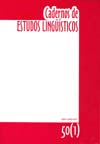Resumo
This study aims to establish a connection between L2 speech production and perception by contrasting the findings garnered from English word and nonword naming tasks performed by 156 Brazilian students of English with their scores at the listening section of TOIEC (Test of English for International Communication). The production-perception relationship is approached in an original fashion in this investigation, since data gathered from L2 production in word and nonword naming tasks is compared to the participants’ performance in listening comprehension tasks of longer excerpts of native speech – rather than perceptual tests of phones or words only. First, we investigated the rate of use of nine grapho-phonic-phonological transfer processes among 156 adult Brazilian ESL students according to their level of proficiency during word and nonword naming sessions. The findings showed a steep and significant decrease in the rate of use of processes of transfer as the level during ESL word production as the participants’ level of proficiency increased. However, when reading nonwords, the students’ performance worsened a great deal, that is, the rate of use of most transfer processes increased regardless of the subjects’ levels of proficiency. Second, in order to assert whether there could be connections between the production results and L2 speech perception. We found inverse and significant correlations.Referências
ALBANO, E. C. (1999). Criatividade e gradiência num léxico sem derivações. In: CABRAL, L. G e MORAIS, J. Investigando a linguagem. Florianópolis: Mulheres, p. 35-54.
BATES, E. e GOODMAN, J. C. (1999). On the emergence of grammar from the lexicon. In: MacWhinney, B. The emergence of language. Mahuah: Erlbaum, p. 29-79.
BATES, E. (2001). On the inseparability of grammar and the lexicon: evidence from acquisition. In: TOMASELLO, M. e BATES, E. Language development. Oxford: Blackwell, p. 124-161.
BEST, C. T, McROBERTS, G. e GOODELL, E. (2001). Discrimination of non-native consonant contrasts varying in perceptual assimilation to the listener’s native phonological system. Journal of the Acoustical Society of America, 109, p. 775-994.
ELMAN, J. (2003). Generalization from sparse input. Proceedings of the 38th Annual Meeting of the Chicago Linguistics Society.
FLEGE, J. E. (2002). Interactions between the native and second-language phonetic systems. In: Burmeister, P., Pirske, T. e Rhode, A. An integrated view of language development: papers in honor of Henning Wode. Trier: Wissenschaftliger Verlag, 217-243.
FLEGE, J. E. (2003a). Assessing constraints on second-language segmental production and perception. In Meyer, A. e Schiller, N. Phonetics and phonology in language comprehension and production: differences and similarities. Berlin, Mouton.
FLEGE, J. E. (2003b). Factors affecting degree of foreign accent in a second language. Palestra proferida no Department of Pscyhology, Carnegie Mellon University, 10 de fev.
HAIR, Jr., JOSEPH F.; ANDERSON, Rolph E.; TATHAM, Ronald L.; BLACK, William C. (1998). Multivariate Data Analysis. 5. ed., New Jersey: Prentice Hall.
HARRIS, Z. (1955). From the phoneme to morpheme. Language. v. 31, 190-222.
JENKINS, J. (2001). The role of transfer in determining the phonological core. In: JENKINS, J. The phonology of English as an international language: new models, new goals. Oxford: OUP, p. 99-119.
KUHL, P. K. (2000). A new view of language acquisition. Proceedings of the National Academy of Science, n. 97, p. 11850-11857.
KUHL, P.K. e IVERSON, P. (1995). Linguistic experience and the “perceptual magnet effect”. In: STRANGE, W. Speech perception and linguistic experience: issues in cross-language research. Baltimore: York Press, p. 121-154.
MAJOR, R. C. (1992). Transfer and developmental factors in second language acquisition of consonant clusters. In: Leather, J. e James, A. (eds.), New Sounds, v. 90, 128-136.
McCLAVE, J. T., BENSON, P. G. and SINCICH, T. (2001). Statistics for Business and Economics. 8th Edition, Upper Saddle River, NJ: Prentice Hall.
MAJOR, R. C. (1987). A model for interlanguage phonology. In: IOP, G. e WEINBERGER, S. Interlanguage phonology. Cambridge, MA: Newbury House, p. 101-122.
McCLELLAND, J.L. (2001). Failures to learn and their remediation: a Hebbian account. In: McCLELLAND, J.L. e SIEGLER, R.S. Mechanisms of cognitive development: behavioral and neural perspectives. Mahwah: Lawrence Erlbaum Associates, p. 97-121.
NATHAN, G.; ANDERSON, W; BUDSABA, B. (1987). On the acquisition of aspiration. In: IOP, G. e WEINBERGER, S. Interlanguage phonology. Cambridge, MA: Newbury House, p. 204-218.
ODLIN, T. (1989). Language transfer: cross-linguistic influences language learning. Cambridge: CUP.
ROHDE, D. L. T.; PLAUT, D. C. (2003). Connectionist models of language processing. Cognitive Studies, v.10, 10-28.
SAFFRAN, J.R. (2001). Words in a sea of sounds: the output of statistical learning. Cognition, v.81, p. 149-169.
SEIDENBERG, M. S.; MacDONALD, M. (1999). A probabilistic constraints approach to language acquisition and processing. Cognitive Science, 23, p.569-588.
SEIDENBERG, M. S.; MacDONALD, M.; SAFFRAN, J. R. (2002). Does grammar start where statistics stop? Science, v. 218.
WODE, H. (1978). Developmental sequences in naturalistic SLA. In: Hatch, E. Readings in second language acquisition. Rowley, MA: Newbury House.
TARONE, E. (1987). The phonology of interlanguage. In: IOP, G. e WEINBERGER, S. H. Interlanguage phonology. Cambridge, MA: Newbury House, p. 70-85
ZIMMER, M. C. (2004). A transferência do conhecimento fonético-fonológico do PB (L1) para o inglês (L2) na recodificação leitora: uma abordagem conexionista. Tese de Doutorado, PUCRS, 187p.
ZIMMER, M. C. (2005). Processos de transferência do conhecimento fonético-fonológico do PB (L1) para o Inglês (L2) durante a recodificação leitora. Cadernos de Pesquisa Lingüística, v. 1, n. 1, p.219-224.
O periódico Cadernos de Estudos Linguísticos utiliza a licença do Creative Commons (CC), preservando assim, a integridade dos artigos em ambiente de acesso aberto.

